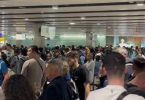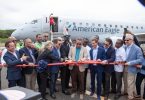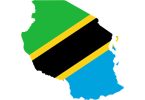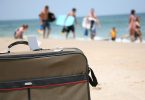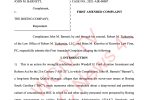A Delta Airlines Boeing 747-400, registration N669US, DL-277 from Honolulu, Hawaii (USA) to Osaka Kansai (Japan) with 359 passengers and 19 crew, was enroute at FL360 about 300 nm southeast of Sand Island/Midway Atoll (USA), when the captain’s windshield cracked prompting the crew to divert to Sand Island’s Henderson Field – runway length 2,410 meters/7,900 feet. The aircraft hit two birds while on approach to Henderson Airfield on Midway Islands causing damage to a flap; the airplane continued for a safe landing about one hour later.
Henderson Field (IATA: MDY, ICAO: PMDY) is a public airport located on Sand Island in Midway Atoll, an unincorporated territory of the United States. The airport was once used as an emergency diversion point for ETOPS operations. It is subsidized by Boeing.
A replacement Boeing 747-400 registration N663US, scheduled to fly the rotation from Tokyo Narita (Japan) to Minneapolis, MN (USA), was positioned from Tokyo to Sand Island as flight DL-9935 picked up the passengers and is currently on the way to Osaka; flight DL-9873 is estimated to arrive with a total delay of 16 hours. A Delta Tokyo to Bangkok flight was cancelled on the 17th because of this, as well as Bangkok to Tokyo, and probably another flight back to the US for aircraft positioning.
The US Fish and Wildlife Service said the passengers were kept aboard until the second 747 arrived. The replacement 747 left at 5:00 am just before daybreak and before sea birds began to fly.
The airline said the aircraft suffered a “major crack” in the windshield. Given the condition of the windshield, the crew could not wait for the landing until after dark, but had to land still in daylight.
The FAA said there was no loss of cabin pressure but the damage was sufficient to divert to Midway Atoll’s runway that serves as an emergency strip for the Pacific.
The airport manager said that they didn’t have sufficient long stairs to serve the airplane. Carpentry workers on the island, therefore, built another set of stairs to go on top of the existing stairs to reach the doorway.
The incident aircraft is estimated to be repaired and able to depart about 24 hours after landing.
The Midway Atoll (or Midway Island, or Midway Islands; Hawaiian: Pihemanu Kauihelani) is a 2.4-square-mile (6.2 km²) atoll located in the North Pacific Ocean (near the northwestern end of the Hawaiian archipelago), about one-third of the way between Honolulu and Tokyo. Midway Atoll is an unorganized, unincorporated territory of the United states. It is less than east of the International Date Line, west of San Francisco, and east of Tokyo. It consists of a ring-shaped barrier reef and several sand islets. The two significant pieces of land, Sand Island and Eastern Island, provide a habitat for millions of seabirds.
According to other sources, Sand Island measures in area include the lagoon within the fringing rim of coral reef. The atoll, which has a small population (approximately 60 in 2009, but no indigenous inhabitants), is designated an insular area under the authority of the US Department of the Interior. The Midway Atoll National Wildlife Refuge, encompassing of land and water (mostly water) in the surrounding area, is administered by the US Fish and Wildlife Service (FWS). The visitor program reopened in January 2008, and there are facilities at the present time for receiving visitors. Currently the best way to travel to the atoll is through organized tour companies. They offer week-long naturalist-led tours focused on the ecology of Midway and the military history. The economy is derived solely from governmental sources and tourist fees. All food and manufactured goods must be imported. The refuge and most of its surrounding area is part of the larger papahanaumokuakea marine national monument.
Midway, as its name suggests, lies nearly halfway between North America and Asia, and halfway around the world from Greenwich, England. For statistical purposes, Midway is grouped as one of the United states minor outlying islands.
Midway is best known as the location of the Battle of Midway, fought in World War II on June 4–6, 1942. Nearby, the United States Navy defeated a Japanese attack against the Midway Islands, marking a turning point in the war in the Pacific Theater.
The first flights to Midway Atoll began in 1935 (US Fish and Wildlife Service 2003). Pan American Airlines used the atoll as a resting point for passengers and crew along its flight route from San Francisco to Hong Kong. The airline flew China Clipper flying boats into Midway that landed on and took off from the ocean. Few or no bird strikes occurred, because the landings and take-offs were on water in the lagoon (inside of the fringing reef) where few seabirds reside.
Tensions during World War II provided the impetus to create a Naval Air Station at Midway beginning in 1940. An airfield was constructed on Eastern Island the same year and was used extensively throughout the war. It was replaced in 1943 with one on Sand Island, portions of which are still used today. Bird strikes undoubtedly occurred during this period, but records have been lost or are incomplete.
Midway remained operational for trans-Pacific military flights. By the early 1950s, about 300 aircraft were refueling at Sand Island each month (Tickell 2000). Procedures to minimize bird strikes were remarkably successful. No aircraft crashed, but delays were caused by bird strikes. Aircraft repairs and replacements were expensive. Around this time, Midway assumed a new role as part of the Distant Early Warning (DEWLINE) defense of the mainland United States. With big jets coming into service, the hazards of air strikes became potentially more serious and costly.
Between 1956 and 1958, the service was contracted to carry out investigations on seabird and aircraft interactions (Kenyon et al. 1958, Tickell 2000). Kenyon et al. (1958) reported 399 albatross strikes during 1728 aircraft landings and takeoffs between November 1956 and June 1957. To discourage birds from soaring or flying in the flight paths of approaching aircraft, the causes of the updrafts (trees and revetments) were removed. Despite these efforts, a large number of birds continued to occupy the flight path, because large grassy fields were found between the runways supporting high densities of albatross. The Navy was forced to kill large numbers of adult albatross in and around the airfield to reduce the wildlife hazard to aircraft. In addition, the Navy also paved large areas on the western parts of the island to prevent albatross from nesting.
In 1965, when radar aircraft discontinued flying from Midway, the killing of albatrosses was no longer necessary. Jets still used the island, but routine monitoring of bird movements and precautionary clearing of runways were adequate for the reduced air traffic (Tickell 2000).
Reporting of bird strikes on aircraft has been sporadic at Midway. Few or no records exist of bird strike frequency from 1965 to 1993, consequently no data from this time period is included in this assessment. In 1993 the US Navy reported 57 strikes during 459 aircraft movements (extrapolated to 1,200 strikes/10,000 movements),(unpublished US Navy data reported in Dolbeer and Arrington (1996). This strike rate is 210 times that of commercial airlines (5.7 strikes/10,000 movements).












